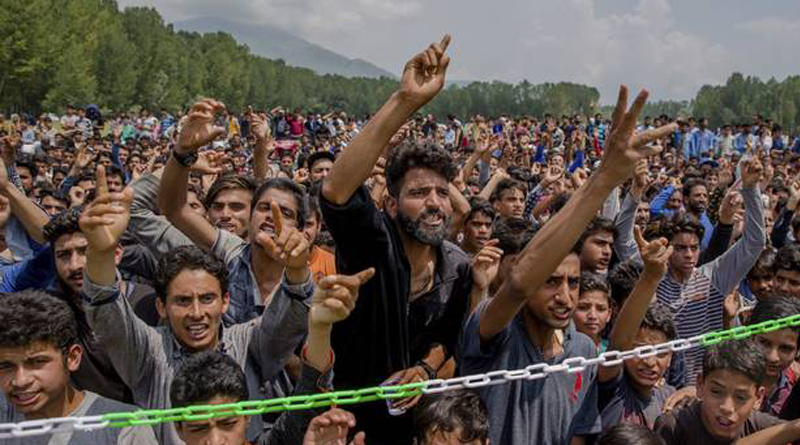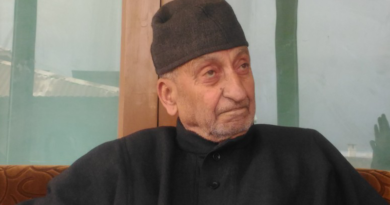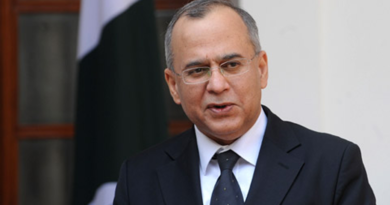The present uprising in Kashmir—-Some Apprehensions
There have been unparalleled public demonstrations in the valley of Kashmir recently, and in terms of numbers at least, these demos might have surpassed those of 1990. The message that is absolutely loud and clear from this mass uprising is that India has miserably failed in killing the peoples’ sentiment for freedom despite the fact that after its armed invasion and occupation of the land of Kashmir in 1947 it has ruled the state on the basis of brute force either without or with a facade of democracy. Apparently the situation presents a very encouraging scenario, but on a slightly deeper reflection some worrying concerns emerge, and all does not seem to be well. In fact, I have a suspicion that the whole uprising could be India-instigated. I will come in a moment to why I have this suspicion, but when I say it could be India-instigated, let me first clearly state very categorically that I do not mean, that all the people, hundreds of thousands and even more, who participated in the demonstrations did so on the behest of India, nor do I mean that India contacted all APHC leaders and those outside APHC to have processions organized. India cannot do that, neither is that the way, colonial forces operate. What is precisely meant is, that the overall game plan of which the recent demonstrations are a part, could perhaps have been laid down by India, APHC and others acted as players in this. Whether these players know where it will lead the movement to, and what will be the shape of things that will emerge at the end of it, is not that important; what is certain and needs to be noted is that these leaders of the movement are definitely not in a position to determine the results of it. It has to be seen how the game plan plays out, and as a universal rule, there are no guarantees that the end result will be exactly the same as envisaged by the authors of the game plan. But that is anyway a different issue, and does not concern us here.
My suspicion is not yet another instance of a conspiracy theory; it is rather based on down to earth logic. It originated as soon as the mass movement started building up in late June, this year, subsequent to Indian government decision of transferring land to Amarnath shrine board.
Intuitively I felt some discomfort first, but later, on some reflection, it turned out that there were essentially two worrying factors. One was the timing of uprising, the other was its genesis, which in turn was going to determine, as it really did, its complexion, the shape the discourse, and also was going to highlight some features like need of road communication with Muzafarabad. All this would have not been at all worrying, if we were looking at these events in a vacuum. But that is not how one looks at things, there is always an intellectual framework within which we analyze them and try to derive conclusions. In this case, we were looking at them in the framework of our understanding of the Kashmir issue, the parties involved, and role of India etc. etc. It is in this process that strong suspicions originate. Subsequent events in Kashmir, Jammu, utterances by various important political figures in and outside Kashmir, and media debates have only strengthened this suspicion.
Worrying Factors
1. Timing
Now let us come to the first worrying factor, that is timing. The current huge uprising came at a time when Pakistan is in great trouble, and is almost paralyzed. But how important is that, we will discuss in the following lines:
For quite some time now, responsible quarters in Pakistan and Kashmir have been publicly saying rather claiming that there has been a considerable progress on the issue of Kashmir through back channel diplomacy. Soon after the recent elections in Pakistan in February, 08 Indian foreign minister visited Pakistan. Later his Pakistani counter part went to Delhi, and extended an invitation to India’s Prime Minister Dr Manmohan Singh to visit Pakistan which the latter accepted. Obviously this visit cannot come about without any progress on Kashmir. Now, the basic question that arises here is: does India want to resolve Kashmir problem? My answer is a big YES. If the answer is yes as it is, does it mean India will give up its sovereignty over Kashmir, and let Kashmir go to Pakistan or simply cede from India. The answer here is a very big NO. But isn’t that a contradiction? Seemingly so, but if we go to the underlying logic, we will see there is no contradiction. India wants to resolve the Kashmir issue because it needs to disengage itself from such conflicts which are like festering wounds. India is the second fastest growing economy in the world, has a viable and fully functional political system, and has a huge power ambition, so it cannot afford to get stuck with governing Kashmir; it has a whole lot of other things to do. This is the dominant opinion in India, and cuts across the party divisions in the Brahmin political establishment. Congress is as much for it, as is BJP (Vajpayee’s musings). Both believe that for an economic and political take-off, India has no choice but to ‘get rid’ of Kashmir problem. I wrote a paper in 1997 where I discussed this point in detail. I brought up the global perspective and how India was groomed to be a major player in the emerging world order. (Pl check out http://www.geocities.com/mahazislami/saamot1.htm)
By the same logic, i.e. the logic of power ambition, India cannot be, and must not be seen to be, a soft state. Whatever the history, the legal position or morality of Kashmir being a de-facto part of India, India will not let any of its parts to cede and its frontiers changed. This goes contrary to its ambition of emerging as a big power.
Now let us see, what is the point I want to make here. The point is very simple and requires only conventional wisdom to understand. India, left to its own, will not let an inch of Kashmir to go, simply because it has been annexed by India into its fold. States are not charity institutions; they do not give away their lands and acquisitions, legal or illegal. At the same time, no state has an infinite capacity to withstand force/pressure. It is only a question of determining what, in terms of force/pressure, is the breaking point of the state, i.e. state’s will. Muster that force, and the state starts yielding. India is no exception. India’s official decision will be not to part with an inch of Kashmir, but at the same time it will engage in diplomacy and rhetoric of creating peace and resolving Kashmir issue, and in its own mind, it will be prepared to surrender only that much which it is made to surrender. That is, it will surrender as much as it will be pressurized to, which means India can give up whole Kashmir. That is not unusual, and can happen. Here, and precisely here, comes the Pakistan factor. The state of Pakistan, and not just the political movement in Kashmir, can bring to bear the requisite pressure on India, that is required to reclaim Kashmir. This is not to underestimate the value of a genuine political movement inside Kashmir for liberation from India, but only to emphasize the fact that there is no substitute to the state power that Pakistan can exert. The ex president Gen Musharraf did a lot of talking on Kashmir, offered proposals to India which were regarded as giving too many concessions, but India did not reciprocate. Apart from other reasons, the main reason could be that India thought it may have to give away what it did not want to. If India shows enthusiasm in resolving the dispute, that conveys the message that it finds a favourable setting at the negotiating table. The pace of the present uprising was such that one would think things are deliberately brought to a level of precipitation.
2. Genesis
Coming to second worrying factor, namely genesis of the present uprising, we can briefly note three main things about it, namely:
One— The matter concerned Kashmiri land, and the issue was, therefore, highly emotive. Moreover since it violated article 370, it was bound to generate resentment across all sections of Kashmiri population including those who form the constituency of National Conference. So it was going to unite all political forces in Kashmir, which it did and continues to do.
Two, It created an equally powerful movement in Jammu, but with exact opposite objectives. The Jammu movement came up as a strong anti-Kashmir movement, and in the subsequent days the focus of Jammu movement changed to what they called 60-year old discrimination at the hands of Kashmiris.
Third, the ball was very clearly kicked off by India. After all why did the issue come up now, why the land was transferred now, when the Yatra has been going on for decades, peacefully and successfully.
Two Worrying Signals
Sometimes it happens that while looking at something that is going on, if you start putting two and two together, you get worrying signals. Same was the case here. We will talk about two worrying signals.
Muzafarabad Chalo
The uprising took off from the land issue, turned into a movement to resolve Kashmir issue, but this time the features that got highlighted to the extent of identifying the movement were such that pro-occupation forces like PDP could find a space in the movement. I am referring to the issue of LOC and road communication with Muzafarabad. This happened because of road blockade by agitators in Jammu. The government of India did almost nothing to prevent the blockade, and the Kashmir movement naturally turned into Muzafarbad Chalo movement. We did not do that, India’s inaction, deliberate or otherwise, did. Miss Mehbooba Mufti of PDP frequently appearing on television channels to argue the case for people’s uprising, said in a program that her party had lost 13 workers in the MuzafarAbad Chalo march. The point to note here is that the road communication between two parts of Kashmir is something which all pro-occupation forces PDP, NC have taken on board, and this is one of the recommendations that Working Groups on Kashmir set up by Indian Prime minister have made in their reports. These things cannot be taken lightly, and one should be aware of the implications of pro-occupation forces finding a space in the Kashmiri’s freedom movement. It has to be noted that when it comes to the resolution of the Kashmir issue, one of the India’s vital considerations will be to save what it believes is its political investment in the state. Political parties like National Conference, PDP and Congress, who uphold Kashmir’s accession to India, are India’s investment, and India will try its utmost to see that in any future dispensation of the Kashmir, these forces are at least accommodated if not at the helm of affairs. One should not make the mistake of underestimating their political value for India. Whatever their profile, their behaviour in different political circumstances, they represent India’s interest in Kashmir.
NC’s Autonomy Plan
Another worrying signal, the one that was apparent right at the start was that the present uprising in the whole of J&K seemed to be setting the scene for the implementation of ‘Autonomy Resolution’ passed by National Conference(NC) in the state assembly a few years ago. The resolution envisaged reorganization of the state of Jammu and Kashmir into a trifurcated entity. Interestingly, and significantly, the Muslim region including the valley of Kashmir looked very much like the one proposed years back by late Sir Owen Dixon with the essential difference that in N.C’s plan this Kashmir region was under full Indian sovereignty, as were that of Ladakh and Jammu. Later, the much publicised Farooq Kathwari map for a semi-independent Kashmir included almost same Kashmir region. It has to be noted that since India has a democratic system, Indian politicians need to do some opinion making before taking any big step about Kashmir. The present uprising and the discourse that followed bore all the hallmarks of a preparatory exercise in this regard. Some APHC leaders while speaking on Indian TV channels openly called for the division of J&K, and senior Indian journalist Mr Prem Shankar Jha while participating in a discussion on NDTV(APHC, and Jammu leaders were also in the program) clearly said that it was right time government of India implemented the Autonomy Resolution of NC. Mr Jha is considered to be a resource person on Kashmir. He was the first person to be consulted by Dr Manmohan singh recently when the later reportedly started taking initiative on Kashmir.
I must clarify, that trifurcation or bifurcation per se is not something that worries me. Division of the erstwhile princely state of Kashmir, as alluded to above, is a common point in so many proposed plans for the resolution of Kashmir issue. The crucial issue here is India’s sovereignty over Kashmir. Three possible scenarios can emerge: a) end of India’s sovereignty over Kashmir; b) Sharing of sovereignty with Pakistan and/or Kashmir; c) maintaining sovereignty as it is. Which of the three happens when any division plan is enacted, will crucially, if not wholly, be determined by the power equation obtaining between India and Pakistan at that point in time. My worry has been that at this point in time, the power equation between India and Pakistan, and the constitution of our mass uprising is such that if a division plan is enacted it may well boil down to NC’s autonomy plan.
***
Dr. Syed M Inayatullah Andrabi is a well-known figure in the circles of political Islam. Born in Srinagar, the capital city of Indian Held Kashmir, Dr Andrabi has been intimately involved at the intellectual level with the global politics and political issues since his student days in 1980 at Pune (India), where he completed his Ph.D. in Linguistics in 1983 at the Centre of Advanced Study in Linguistics, Deccan College, University of Pune, Pune, India. Upon completing his doctorate he returned home to join the University of Kashmir, first on a post-doctoral fellowship and later as faculty, but could not continue because of the deteriorating security situation in Kashmir, and had to move to United Kingdom in 1994 where he continues to live since along with his wife and five children.




